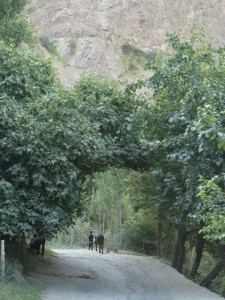Tajik women, if they wish to cover their head, do so with a floral scarf pulled low over their forehead and knotted behind their head, pirate style. The older women still wear long dresses with scoop necks bordered in sequins, thick socks and sandals. But the young women adore their tight jeans, their sexy tops, their barrettes and braided hair. So many here look of European ancestry, with fair skin, pale green/blue/hazel eyes, freckles and sharp chins.
Kyrgyzstan, like Tajikistan, is blessed with rivers, so much so that they say there’s 500 litres per person per day, that is if they can all get it. For some, the apricot trees in their orchards are heavy with fruit; for other, the fruit has dried on the branch. In other words, there are water wars here just like in the American West, and this precious resource is taken by whoever can get it. The harvest here is well-advanced. Pendulous sandy orange butternut squash the size of a toddler, and green/brown kubochas as big as rugby balls are heaped next to piles of blood red peppers and russet potatoes in 50-lb red mesh sacks. Dry cornstalks are wrapped in bunches and field stacked, waiting for a free donkey to carry the bundles home as winter fodder for the dairy cows.
Herds of everything are moving along the highway to market: tall brown fat-tail sheep, big cows, sleek horses with weanlings at their side. We are into nomad country, legacy of the Mongols who stamped their imprint on the Kyrgyz, replacing Euro features with swarthy skin, long faces, flat noses, black oriental eyes and a need to roam. Since independence from the USSR in 1991, the German auto makers colonized Kyrgyzstan (Uzbekistan got Chevrolet…). Kyrgyz roads are populated by Mercedes, BMWs, Volkswagens and Audis.
At 10,200 feet we cross a snow-covered Kyrgyz pass and sweep down into the broad lush grass plain of the Chychkan River valley, Brunhilde playing at being a Mongol horde all on her own. Summer yurts dot the landscape, smoke curling out of stove pipes in the grey rain, many with an Audi out front. These nomads make use of all kinds of horsepower! The area and the canyon behind are famous for their beekeepers. Each yurt has a small table out front with recycled Fanta, Coke and Sprite bottles brimming with gold honey and also with milk. I think it’s cow or sheep milk. Too late I realize it’s mare’s milk, a beverage that’s long been on my agenda to try.
In Bishkek the closest I can come to mare’s milk is the fermented version, called Kumus. I order some at a cafe and a pitcher is brought, with more kumus than any Colorado girl would want to drink. I pour some into a glass, sniff it and take a cautious sip. I’m expecting a taste akin to sour kefir. What I get instead is a wallop of something so rank that I can barely swallow. I am depressed that I cannot actually drink more, but the description I could give of the taste sensation is so unsavory that I’m not even going to write it.
Next day, on our way to Naryn, last stop in Kyrgyzstan before China, luck is with me. After many miles of dry hills not conducive to herds of horses, we cross another pass and on the down side hit meadows. And yurts. And horses. Pulling over to the first tent we see, I ask the young mother standing there whether she has milk. She motions me into her tent and says “Kumus?” I do not vigorously shake my head, but instead politely suggest that I will not drink any kumus that afternoon. Instead I mime milking, which I can do because, if you recall, I milked a cow in Cordoba, Argentina. So I know the right motion to make. And she gets it!!
Out we go to the shady side of the yurt where there’s a black bucket half full of milk. She ladles some out into a china bowl and hands it to me. After my kumus experience the day before I’m a little gun-shy, but I’ve come a long way for this, so I’m not about to be timid. I take a good sip. The liquid is cool, mild and faintly sweet, with none of the fattiness of cow milk and none of the pungency of goat or sheep milk. It’s delicious, but I am aware that with each sip I could be imbibing more bacteria than my belly will be able to deal with. It’s entirely possible that in 2 hours I’ll be heaving my guts out. But that’s then and this is now, so I stand in the close-cropped field sipping my mare’s milk while the grandmother squeezes curdled kumus into oblong balls and rests them on the netting above her, there to dry into stone-hard cheese balls that will keep for a year.
-Dina











